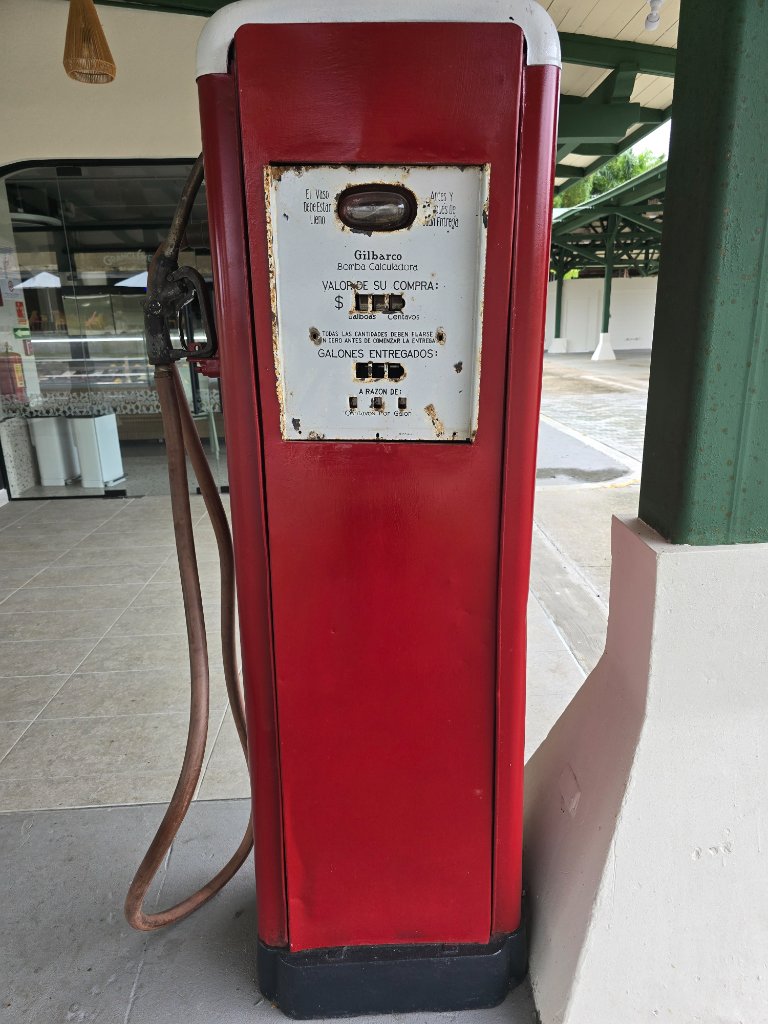Vintage Gilbarco Gas Pump in Panama
Failed to generate audio
What you're looking at is a vintage Gilbarco computing gas pump, an intriguing artifact from an era when fueling up a car was a more manual, and perhaps more engaging, experience. While it's no longer pumping gas, it serves as a wonderful example of early 20th-century technology, and its presence here in Panama's City of Knowledge, a hub for education and research, is quite fitting.
This particular model, a Gilbarco computing pump, would have been considered quite advanced in its day. Unlike earlier pumps where an attendant might have to manually calculate the cost of the fuel, these "computing" pumps automatically displayed both the total value of the purchase and the number of gallons dispensed. The text on the pump, which is in Spanish, highlights these features. "Gilbarco Bomba Calculadora" translates to "Gilbarco Computing Pump". Below that, "VALOR DE SU COMPRA:" means "VALUE OF YOUR PURCHASE:", displaying the cost in dollars and cents. Further down, "GALONES ENTREGADOS:" indicates "GALLONS DELIVERED:". You can also see "A RAZON DE:", which means "AT A RATE OF:", suggesting where the price per gallon would have been shown. The phrase "El Vaso Debe Estar Lleno" at the top left translates to "The Glass Must Be Full", likely a reminder for the attendant to ensure the measuring glass, which was visible on some older pumps, was completely filled for accurate measurement.
What might seem unusual to a modern observer is the prominent hose and nozzle, which are quite robust and, in their current condition, show the wear and tear of decades. The overall design, with its classic red and white livery and the visible dials, evokes a strong sense of nostalgia for a bygone era of roadside service stations. These pumps were not just functional; they were often iconic elements of the American automotive landscape that spread across the Americas, including Panama. They represent a significant step in the evolution of everyday technology that we now take for granted.
Antique Gilbarco Gas Pump
Failed to generate audio
You've discovered an antique Gilbarco calculating pump, likely from the mid-20th century, a relic from a time when gas stations looked and operated very differently. Before digital displays, these pumps used mechanical dials to show the "Valor de Su Compra" (total cost) in dollars and cents, and "Galones Entregados" (gallons delivered).
The text "El Vaso Debe Estar Lleno" and the visible glass dome at the top of the display relate to what's called a "visible pump" or "gravity pump" system. In earlier designs, the gas was first pumped into a visible glass cylinder at the top, allowing the customer to see the exact volume being dispensed and verify its quality before it flowed by gravity into their car's tank. This was especially important in an era when fuel quality and measurement accuracy were less regulated than today, helping to build customer trust.
Gilbarco, short for Gilbert and Barker Manufacturing Company, has a long history in the gasoline pump industry, originating in the United States in the late 19th century. They were pioneers in developing many of the features we take for granted in modern fuel dispensers. While this particular pump is no longer in active service, it stands as a testament to the evolution of technology and the golden age of motoring.
Antique Gilbarco Gas Pump in Panama
Failed to generate audio
This is an antique Gilbarco gas pump. Gilbarco is a major manufacturer of fuel dispensers, founded in the US in 1865, originally as the Gilbert & Barker Manufacturing Company. This model, a calculating pump, was a significant innovation, as earlier pumps required attendants to manually calculate the cost based on gallons dispensed. The text "VALOR DE SU COMPRA" and "GALONES ENTREGADOS" (Value of your purchase, Gallons delivered) indicates it's set up for a Spanish-speaking market, like Panama. "El Vaso Debe Estar Lleno" and "Antes y Despues de Cada Entrega" are safety/operational instructions: "The glass must be full" and "Before and after each delivery". The wear and tear suggest it's been in service for decades, now likely a decorative piece.
